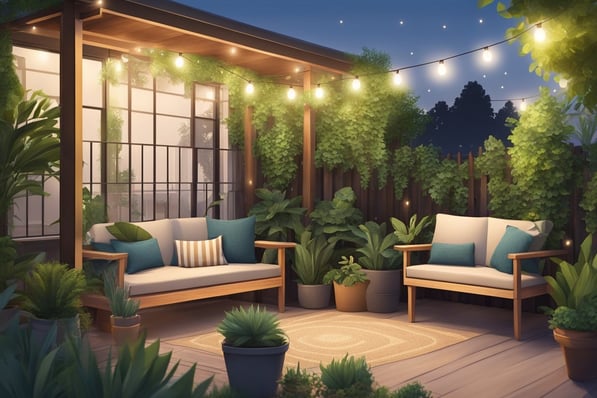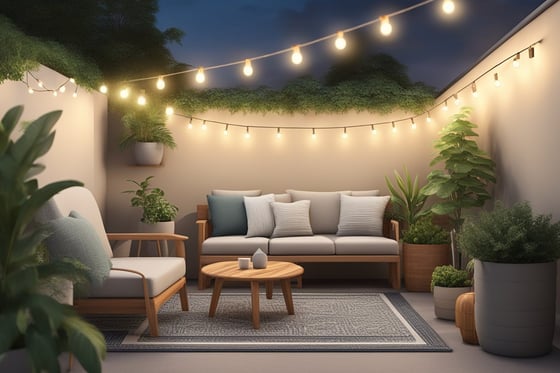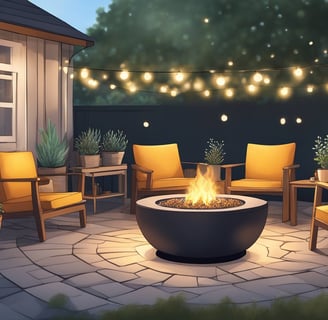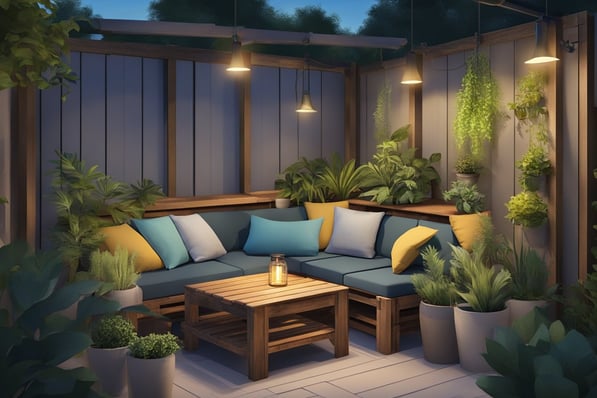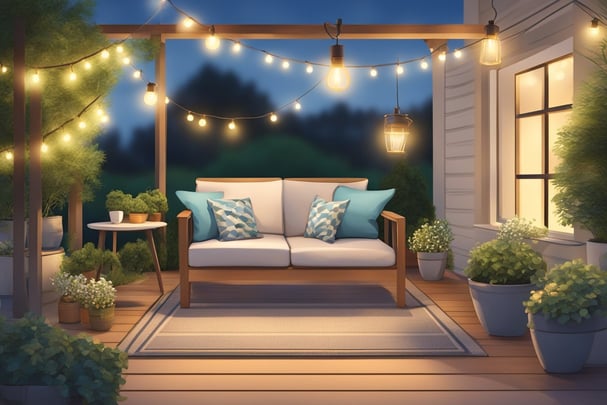Creating a Cozy Outdoor Seating Area on a Budget: A Complete Guide
11/8/20246 min read
How to Create a Cozy Outdoor Seating Area on a Budget: Tips for Affordable Comfort
Creating a cozy outdoor seating area without spending a fortune can transform any backyard into an inviting retreat. With some creativity and the right approach, it’s possible to design a comfortable and stylish space where friends and family will love to gather. Emphasizing affordable furniture and decor can provide comfort and functionality without a hefty price tag.
Utilizing recycled materials and thrift finds can also add a unique charm to the outdoor setting. Choosing weather-resistant fabrics and multifunctional pieces helps maximize use throughout the year. Small touches like potted plants or soft lighting contribute significantly to the ambiance, enhancing the overall coziness.
An effective layout is essential for comfort and aesthetics. Arrange seating to encourage conversation and create an environment where everyone feels at ease. With thoughtful planning and budget-friendly strategies, anyone can enjoy a welcoming outdoor seating area that balances comfort, style, and affordability.
Conceptualizing Your Space
Creating a cozy outdoor seating area starts with a clear vision of your space. Evaluate the available area, determine how you wish to use it, and select a theme that complements the environment.
Assessing Your Outdoor Area
Begin by measuring the dimensions of your outdoor area. Use a tape measure to get accurate figures, and take note of any permanent features like trees or pathways. Knowing the size and layout will dictate what furniture fits best.
Consider the climate and weather conditions. Areas with lots of sun might benefit from shade structures. Look at the ground surface to see if any leveling or decking is needed to make the area comfortable for use.
Observe the view and surroundings. Choose a focus point such as a garden or a scenic view. This will help to arrange seating in a way that enhances the experience of the space.
Defining the Purpose of Your Seating Area
Identify how you envision using your outdoor area. Is it primarily for relaxing, dining, or entertaining? Each function has specific needs in terms of design and furniture.
For a dining space, consider a table and chairs that can withstand weather changes. If relaxing is the primary goal, opt for loungers or a hammock.
Think about the number of people the area should accommodate. This affects the choice of furniture and layout. Balancing functionality with aesthetics ensures that the space is both practical and inviting.
Choosing a Design Theme
Select a design theme that aligns with the existing architecture and natural surroundings. A theme helps create a cohesive look by influencing color choices, furniture styles, and decorations.
For a rustic look, use natural materials like wood and stone. An eclectic style might incorporate a mix of colors and patterns.
Choose elements like cushions and throws in coordinating shades. Plants and fairy lights can add warmth and character. A unified theme enhances the attractiveness and comfort of the seating area.
Budgeting and Planning
Creating a cozy outdoor seating area on a budget involves strategic planning and smart choices. Focus on setting a practical budget, choosing affordable materials, and optimizing the layout to maximize space and comfort.
Setting a Realistic Budget
Starting with a budget guides all decisions, ensuring spending stays within limits. Consider what features are essential, such as seating, lighting, and plants. Research typical costs for each element and set a spending range. It is crucial to allocate funds for unexpected expenses.
Break down costs by category in a table or list format:
Seating: Chairs, benches, cushions
Lighting: String lights, lanterns
Decor: Planters, outdoor rugs
Plants: Affordable or DIY options
Be flexible, allowing room for adjustments.
Identifying Cost-Effective Materials
Choosing materials wisely can drastically lower expenses. Opt for reclaimed wood for furniture, which is often cheaper and adds charm. Consider upcycled materials such as repurposed pallets for creating tables or seating.
Explore local thrift stores for budget-friendly items like cushions or decor pieces. Focus on durability and weather resistance to ensure longevity, avoiding costly replacements. Make a list of materials and compare prices from different suppliers to secure the best deals.
Planning Your Layout
A well-thought-out layout maximizes the effectiveness of the space. Measure the area to understand constraints and possibilities. Sketch out different setups to see what works best with the materials and furniture chosen.
Consider practical placement of key features: seating near light sources, plants for privacy, and tables within easy reach. Allow pathways for easy movement. Incorporate multi-purpose furniture, like storage benches, to save space and costs. Adjust the plan to fit personal style and comfort needs.
DIY Projects and Upcycling
Creating a cozy outdoor seating area on a budget can be achieved by building homemade furniture and repurposing existing items. These approaches enable the use of creativity while maintaining cost efficiency and enhancing sustainability.
Building Homemade Furniture
Constructing your own outdoor furniture is an excellent way to save money and personalize your space. Simple projects like pallet sofas or plywood benches can provide durable and stylish seating options.
Using reclaimed wood adds a rustic touch while reducing costs. Basic tools such as a saw, hammer, and drill are often sufficient for these tasks.
For comfort, consider adding DIY cushions made from weather-resistant fabric. Outdoor sealant can be applied to wooden surfaces to extend the furniture’s lifespan. A coat of paint or wood stain can enhance the appearance and bolster protection against the elements. This approach not only cuts costs but also allows customization to fit personal tastes.
Repurposing Existing Items
Repurposing adds a unique charm to outdoor areas by transforming old items into functional pieces. An unused ladder can become a quirky shelf for potted plants or books. Old barrels make excellent tables or stools.
Look for unused items around the house that can be revamped for outdoor use. Metal buckets can be turned into plant pots or footrests when topped with a cushion. An old door can serve as a garden table with the addition of legs.
Choosing to upcycle not only minimizes waste but also adds originality to the space. With some imagination, everyday objects can gain a new lease on life, saving money and creating a more personal outdoor setting.
Accessorizing and Decorating
Transforming an outdoor seating area into a cozy retreat involves thoughtful accessorizing. Soft cushions, ambient lighting, and vibrant plants play key roles in enhancing comfort and aesthetics.
Selecting Comfortable Cushions and Throws
Choosing the right cushions and throws can vastly improve the comfort of an outdoor space. Opt for weather-resistant fabrics to withstand varying conditions. Sunbrella or polyester blends are durable choices.
Consider colors and patterns that complement the surroundings. Bright hues add vibrancy, while neutral tones bring elegance.
Tip: Layering cushions of different sizes creates depth and interest. Adding a plush throw provides extra warmth during cooler evenings, making the space inviting year-round.
Ensure that the cushions and throws are easy to clean, preferably machine-washable, to maintain their appearance with minimal effort.
Adding Lighting Elements
Lighting enhances the ambience and extends usability of an outdoor area into the evening. String lightsare popular for a soft, inviting glow. They are easy to install and versatile. Hang them overhead or weave them through railings or trees.
Lanterns provide a more rustic feel. They can either be battery-operated or solar-powered, making them affordable and eco-friendly.
Opt for solar LED stake lights along pathways or around seating areas for added safety and charm. Consider smart lighting options that allow for customizable brightness and colors via an app, adding convenience and flexibility.
Incorporating Plants and Greenery
Plants and greenery introduce life and color. Choose low-maintenance plants suited to your climate, like succulents or ferns. Potted plants allow flexibility and can be rearranged to refresh the look.
Planters: Different heights and styles add variety. Use matching sets for a cohesive look or mix styles for a more eclectic vibe.
Climbing plants on trellises or around pergolas bring vertical interest and can provide shade. Select fragrant flowers, such as lavender or roses, to enhance the sensory experience.
Consider incorporating an herb garden for functional beauty. Basil, mint, and rosemary are excellent choices and can be easily grown in small containers.
